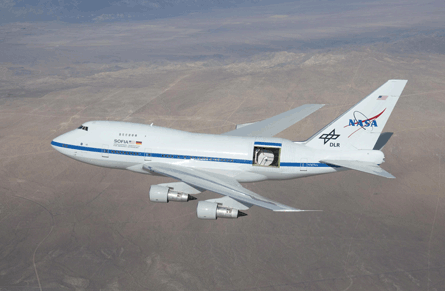NASA reports positive results from initial open-door testing of its Stratospheric Observatory for Infrared Astronomy (Sofia), a research platform that includes a 19t telescope mounted on a Boeing 747SP (N747NA).
A 4.6m (15ft)-high by 4.3m-wide door on the aft left side of the aircraft that opens in flight to expose the telescope a clear view of the sky between 23° and 58° of elevation had been a key concern among engineers.
The result of two decades of engineering at a cost of more than $500 million in modifications, the 747 includes "ramps" and fairings designed to isolate the telescope from atmospheric buffeting as the former Pan Am and United Airlines aircraft flies at M0.85 and 45,000ft during observations. Modifications were made by L-3 Communications at the company's Waco, Texas facility.
 |
|---|
© NASA |
Open door tests on two of the four flights made since 9 December however have proven "nominal" from the buffet isolation standpoint, says Sofia programme manager Bob Meyer. During a 14 December test, Meyer says the crew opened the door to 10% of its fully open position, followed by an 18 December flight in which the door was opened to its 10%, 40%, 70% and 100% open positions, albeit only for 2min as per the flight test plan.
Tests were conducted at 15,000ft altitude and a speed of 225kt (415km/h) with the telescope turned off and locked in position, says Meyer. The fourth flight was cut short with no door opening due to a telemetry system problem.
"Everything looked nominal," says Meyer. "Pilots reported no change in handling qualities and sound pressure levels were as we predicted." In 2010, NASA plans to open the operational envelope for the aircraft, including tests with the telescope's pointing control system activated and "first light" operations of the telescope itself. First science flights are planned for autumn 2010.
A crucial test of how the aircraft handles with its door stuck in the fully open position is scheduled for early this year, says Meyer. The system was designed to handle 20min of worst case resonance with a factor of four safety factor, enough to allow the pilots to descend and land safely if the door fails in the open position.
Source: Flight International























